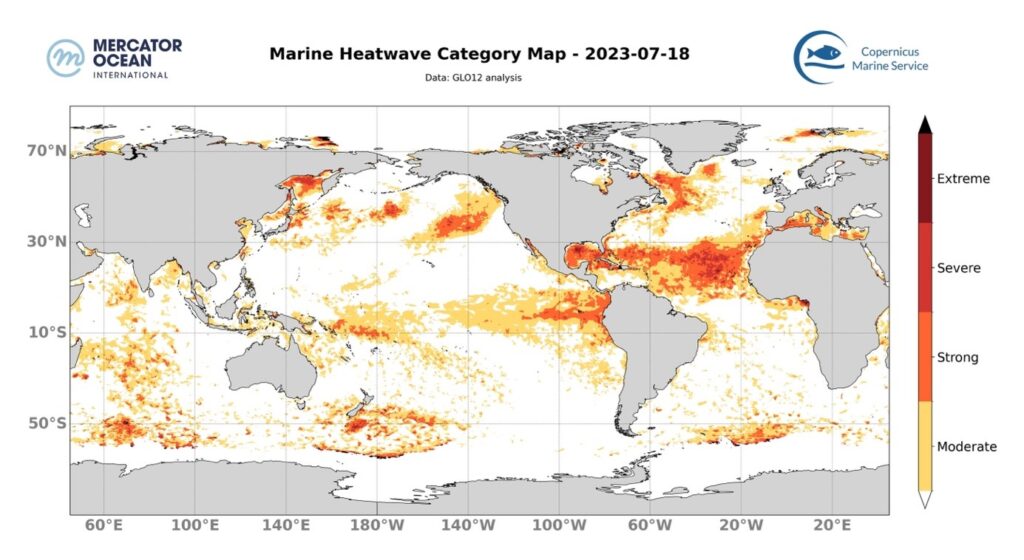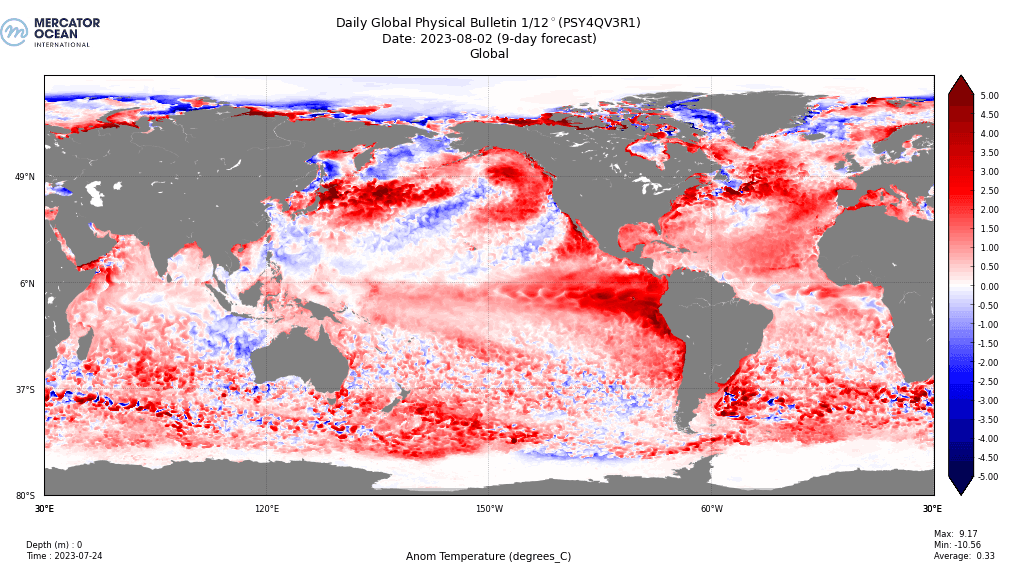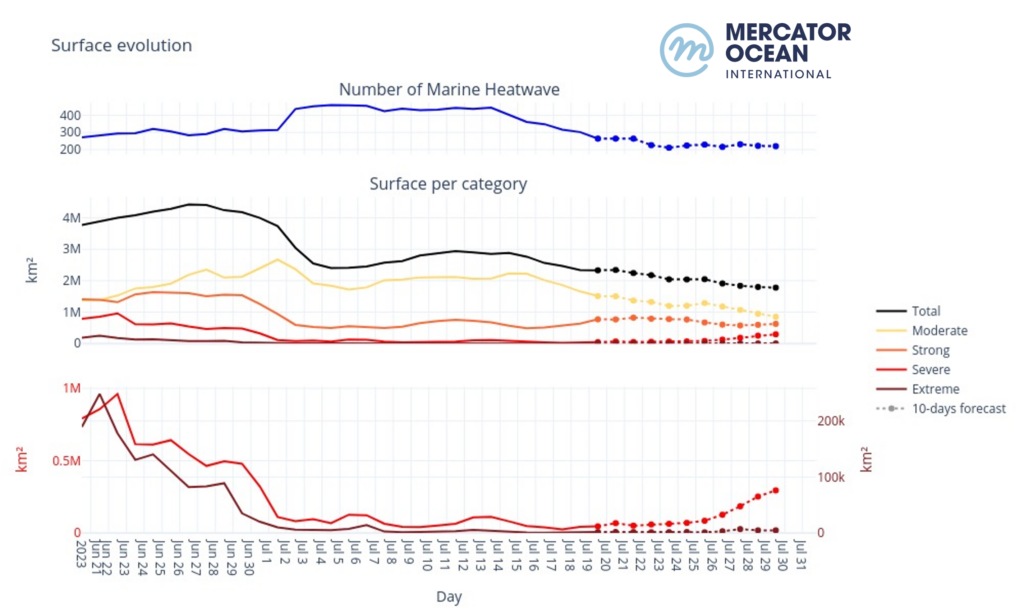Mercator Ocean International oceanographers examine marine heatwaves across the global ocean for the month of July and forecasts for the first days of August 2023. They analyse a variety of datasets from observation analyses (satellite sea surface temperature maps) to model analyses (assimilating satellite and in situ observations) and model forecasts.¹


Assessment of the current month July 2023
- The heatwave in the western Mediterranean has spread to the whole of the eastern basin, maintaining a strong to severe category in the Alboran Sea and the south-western Mediterranean. The regions around Italy and to the north of Tunisia are also experiencing a strong heatwave, as is the case locally in the eastern Mediterranean basin. The greatest temperature anomalies are to be found in the south-west, with weekly values reaching 5°C locally (compared with the average values obtained over the same week between 1993 and 2016).
- The heatwave that swept across most of the north-east Atlantic in June has diminished significantly in geographical extent, affecting only the Iberian Peninsula, and has become moderate to locally intense. Weekly anomalies are reaching 2 to 2.5°C over the Bay of Biscay.
- A heatwave is still present in the tropical North Atlantic (from 15°N to 30°N) and stretches across the entire width of the basin, ranging from strong to severe in the east and moderate to strong in the west.
- The area south of Greenland has been subject to a heatwave for over a week, which now extends beyond the Labrador Sea to southern Newfoundland.
- The heatwave in the north-east Pacific remains moderate to strong.
- The tropical Pacific is experiencing a moderate heat wave reaching high intensity near the coast of Peru, which is consistent with current El Niño conditions.
- There are also heat waves in the southern hemisphere in the south-western Pacific to the east of New Zealand.
Forecasts from the 4rd week of July 2023 onwards
- The heatwave present throughout the Mediterranean basin is intensifying over the whole eastern half from Tunisia to the Middle East, rising from moderate to locally strong to strong and severe between Libya and western Greece, as well as the eastern end of the basin. The average weekly temperature is above 3°C for most of the western basin, exceeding 5°C over Tunisia, the Tyrrhenian Sea and western Corsica.
- In the north-east Atlantic zone, the heat wave continues to diminish until it disappears. In the north-west Atlantic, on the other hand, the heatwave is increasing in size as it spreads eastwards, and its intensity is increasing from strong to severe in the Labrador Sea and eastern Newfoundland.
- The heatwave in the tropical North Atlantic stretching across the entire tropical band remains stable in the models.
- The heatwave in the tropical North Pacific is intensifying eastwards over Central America.

The bottom panel shows the curves for the severe (red) and extreme (brown) heatwaves in the middle panel, on a smaller scale to give a clearer picture of the trends (on the left, up to 1,000,000 square kilometres for the severe category; on the right, up to 250,000 square kilometres for the extreme category).
Criteria used: Oliver et al (2021) https://doi.org/10.1146/annurev-marine-032720-095144
Marine heatwaves (MHW) are extreme rises in ocean temperature for an extended period of time. They can occur at different locations in the ocean, and their magnitude and frequency have increased over the last couple of decades, with harmful impacts on ecosystems, and human activities. According to the latest report released by the Intergovernmental Panel on Climate Change (IPCC AR6 SYR), it is found with high confidence that in the near-term at 1.5°C global warming, the increasing frequency of marine heatwaves will increase risks of biodiversity loss in the oceans, including from mass mortality events.2
How are marine heatwaves calculated?
A marine heatwave is a heat episode during which the temperature is significantly higher than a certain threshold for at least 5 consecutive days.

The seasonally-varying threshold is defined on a daily basis according to a sufficiently long climatic period (in this case 1993-2016). So, for a given place and a given day, knowing all the surface temperatures observed over the last 30 years, a heatwave situation is defined as one where the temperature measured is within 10% of the maximum values observed (i.e. above the 90th quantile, see diagram), for at least 5 consecutive days.
The main characteristics of heatwaves are their duration and intensity. The intensity for a given day corresponds to the value in degrees above the 90th quantile (blue arrow), which can either be calculated as the cumulative intensity throughout the heatwave event, or the maximum intensity.
Heatwaves are categorised on the basis of their deviation from the mean temperature or anomaly (green arrow): a deviation of more than 2 times the difference between the 90th quantile and the mean corresponds to a heatwave in the strong category; a deviation of more than 3 times corresponds to a heatwave in the severe category; and a deviation of more than 4 times corresponds to a heatwave in the extreme category.
¹Analysis of datasets: OSTIA sea surface temperature observations analysis (Copernicus Marine Service), OISST sea surface temperature observations analysis (NOAA), GLO12 model (Copernicus Marine Service, Mercator Ocean International)
² IPCC AR6 SYR 4.3 https://www.ipcc.ch/report/ar6/syr/downloads/report/IPCC_AR6_SYR_LongerReport.pdf
